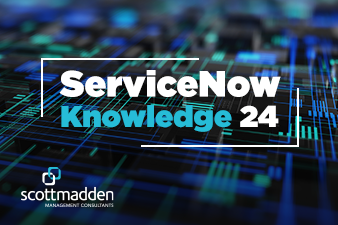Insights
Featured Insights

Tackling the Talent Shortage
ArticleThe shortage of experienced talent in the marketplace coupled with an aging workforce has left many organizations without the necessary workforce skills to meet current demand or…
READ MORE
Fleet Electrification Planning
ArticleFleets across the country are transitioning to electric vehicles. Companies and government entities are looking to electrify their fleets in order to meet carbon-reduction goals, and growing…
READ MORE
Mastering Change Management for Organizational Success
ArticleIn business, change is constant. Organizations must continually adapt to survive in today’s competitive market. No matter what business you’re in, your organization is likely going through…
READ MORE
Protected: Elevate Your ServiceNow Implementation with ScottMadden
ArticleThere is no excerpt because this is a protected post.
READ MORE
Navigating Lead Time Deterioration in Electric Utilities
ArticleFor electric utilities, where the delivery of critical components like transformers directly impacts service levels, managing lead times is not just strategic—it's essential. Lead time deterioration, characterized…
READ MORE
SpareLogic – Understanding What Matters
PillarWith SpareLogic, step into a world where spare part management is no longer a guessing game, but a strategic, data-driven process.
READ MORE
StockStatus Interactive: Revolutionizing Inventory and Material Management
PillarStockStatus Interactive is your partner in achieving a streamlined, efficient, and proactive supply chain management process. Let us help you make informed decisions and reduce operational roadblocks.
READ MORE
Security Staffing Assessment and Organization Design
Case StudyScottMadden analyzed work activity across an enterprise and redesigned organizational roles to align with the most urgent security needs.
READ MORE
Security Controls Assessment and Implementation
Case StudyTwo large U.S. energy companies merged and needed to standardize their security controls across the newly consolidated enterprise.
READ MORE
Telecommunications VoIP and Data Circuits
Case StudyScottMadden supported a complex, whole-system upgrade of legacy telecommunications equipment for a midsize southwestern utility.
READ MORE
Offshore Wind Development Go-to-Market Strategy Assessment
Case StudyRegional characteristics, including policy, key local market participants, and local energy generation economics, are key considerations when creating clean energy development projects.
READ MORE
Security Awareness Program Design and Implementation
Case StudyScottMadden assessed awareness of security standards and requirements and created a standardized communication program for all internal stakeholders.
READ MORE